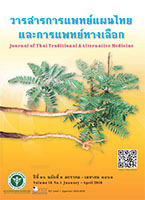Safety, Effectiveness and Satisfaction of Postpartum Mothers in Yoofai Treatment Based on Thai Traditional Medicine
Main Article Content
Abstract
Yoofai is a process of rehabilitating the postpartum mothers’ health to normal or almost normal life rapidly., but postpartum mothers chose to use the method of Yoofai treatment at public hospital lower than their targeted goal in spite of having been treated for along time. This may be because they think that safety and effectiveness of Yoofai treatment of postpartum mothers, as well as their satisfaction toward Yoofai treatment are still doubtful. The purposes of this research are to analyze safety and effectiveness of Yoofai treatment of postpartum mothers, and evaluate satisfaction of postpartum mothers toward Yoofai treatment. The sample was chosen by using selective sampling from the population of postpartum mothers in Nakornpathom Province with the number of 30 persons. The data were gathered between May and July, 2016. The statistical techniques used for analyzing the data were percentage, mean, standard deviation (S.D.), and repeated measures ANOVA at the significance level of 0.05. The research findings were that: 1) The postpartum mothers who had the Yoofai treatment were safe at the very high level (96.67%). 2) After Yoofai treatment, involution of uterus of all postpartum mothers reduced at the low level (100 %). Ninety pecent was no perineal pain and 93.33 percent was no body pain. 3) When comparing the effectiveness, the high of uterus, perineal pain, and body pain. between before-Yoofai and after-Yoofai treatment was statistically significant different at α 0.05. And 4) the postpartum mothers were satisfied with Yoofai treatment at the highest level (80 %). These research findings confirm that the Yoofai treatment was safe and helpful in reducing involution of uterus, perineal pain and body pain
Article Details
References
2. Hengtragoon, Arroonwon. “Thai Traditional Medicine,” Interviewed on February16, 2014. (in Thai).
3. Daratum, Pittayapon, Pay Attention to Health: Thai Wisdom, “Yoofai” of Postpartum Mothers Assists Modern Mothers to Rehabilitate Their Health. [Internet]. 2010 [2016 November 27]; https://www2.manager.co.th/Politics/ViewNews.aspx?NewsID=9530000106543 (in Thai).
4. Department of Thai Traditional Medicine, Ministry of Public Health. Handbook of Midwifery Guideline with Thai Traditional Medicine. Bangkok: The War Veterans Organization of Thailand; 2014, 112 p. (in Thai).
5. Office of Nakornpathom Public Health. Annual Report on Performance: Year 2014. n.d. 2015, pp. 19. (in Thai).
6. National Health Security Office (NHSO). A Guideline of Operating Thai Traditional Medicine for Rehabilitating Postpartum Mothers in the System of Universal Health Coverage. [Internet]. 2010, pp. 1 – 6. [2016 November 27]; https://www.nhso.go.th/downloadfile/fund/CPG (in Thai).
7. Cohen, J. A Power Prime. Psychological Bulletin. 1992; 112: 155-9.
8 Fedorczyk, J. The Role of Physical Agents in Modulating Pain. 1997; 10: 110–21.
9 Teerachitgul, Juljira; Narkar, Khanittha; Boonpat, Piyaporn. Management of Muscular Aches and Pains in Old-Age Rubber Tappers. Thai Journal of Nursing Council. 2012; 27(2): 134-47. (in Thai).
10 Parasilp, Nichapa; Kumfoo, Sirintip; Tumthai, Artjamon. Immediate Effects of Thai Herbal Hot Pack Treatment on Pain and Lower Back Flexibility: A Pilot Study, Songklanakarin Medical Journal. 2560; 35(3): 221–9. (in Thai).
11 Boonstra, AM; Schiphorst, Preuper HR.; Balk, GA.; Stewart, RE. Cut-off points for mild, moderate, and severe pain on the visual analogue scale for pain in patients with chronic musculoskeletal pain. PAIN. 2014; 155(12): 2545 -50.
12 Hongratana, Worakit T. Physiological effects in aromatherapy. Songklanakarin Journal of Science and Technology. 2004; 26(1): 117-25.
13 Saelim, Jutamart; Tunthai, Kitti; Kuntiworrapong, Sodsai; Anuntasarun, Jakkrit. The Co-application of Thai Medical Practices and Medical Sciences in Pregnancy Cares: A Case Study of Moo Baan Thato, Amphur Sadoa, Songkhla Province. The Fourth Hardyai Academic Conference on Research for Developing Thai Society; May 10, 2013; Prince of Songkla University. (in Thai).
14. Office of Basic Education Commission, Ministry of Education. Medical Welfare: Medical Wisdom and National Literary Heritage. Ed.3. Bangkok: Office of the Welfare Promotion Commission for Teachers and Education Personnel. Publishers: Lardprao, 2004: 128-9. (in Thai.).
15. Kunsopitbunnaluck (Umparn Gittikajorn). Kumpee of Ancient Thai Traditional Medicine Vol.2. Pranakorn: Ootsahagumgarnpim; n.d., 294 p. (in Thai).
16. Jamjarn La-eard, Kuntarucksawong Suree, Hongtong Soontorn, Jumpated Noppanat. Thai Traditional Medicine for Postpartum Mothers in the Communities of the Central Region. Journal of the Royal Thai Army Nurses. 2557;15(2): 195 – 202. (in Thai).
17. Shelley, Maynard W. Responding to Social Change. Dowden, Pennsylvania: Hutchison, 1975: 350 -5.
18. Phanida, Ka. The Practice of Lying by the Fire of the Mothers After Childbirth in Thai Traditional Medicine: A Case Study of Northeastern Thai People at Ban Dong Mafai, Suwannakhuha District, NongBua Lam Phu Province. (Master of Science). Applied Thai Traditional Medicine, Graduate School Bangkok: Suan Sunandha Rajabhat University, 2016, 168 p. (in Thai).


